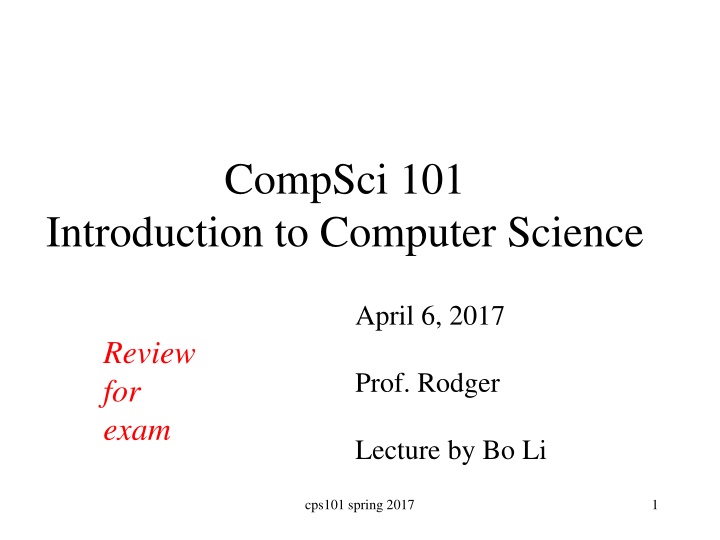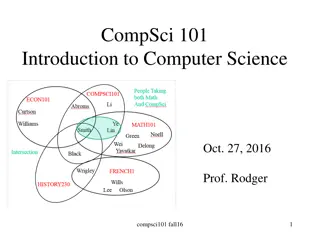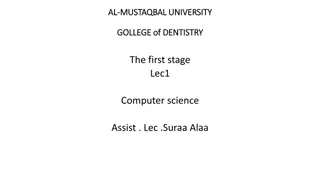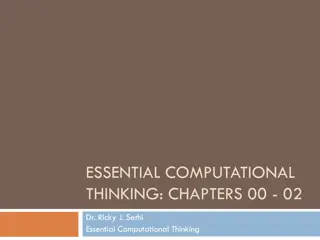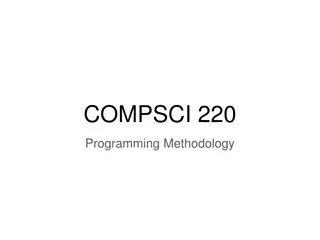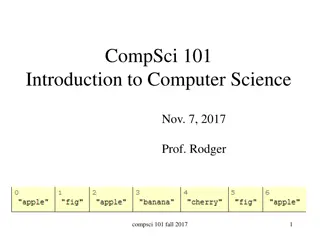CompSci 101 Introduction to Computer Science
In this review material for computer science students, the focus is on sorting algorithms and APIs in Python. Topics covered include understanding how sorting works using the sorted() and .sort() methods, leveraging the stable part of the API specification, and exploring ways to customize sorting processes. The review delves into practical examples and explanations to aid comprehension and application in coding tasks.
Download Presentation

Please find below an Image/Link to download the presentation.
The content on the website is provided AS IS for your information and personal use only. It may not be sold, licensed, or shared on other websites without obtaining consent from the author.If you encounter any issues during the download, it is possible that the publisher has removed the file from their server.
You are allowed to download the files provided on this website for personal or commercial use, subject to the condition that they are used lawfully. All files are the property of their respective owners.
The content on the website is provided AS IS for your information and personal use only. It may not be sold, licensed, or shared on other websites without obtaining consent from the author.
E N D
Presentation Transcript
CompSci 101 Introduction to Computer Science April 6, 2017 Review for exam Prof. Rodger Lecture by Bo Li cps101 spring 2017 1
Announcements Exam 2 Tuesday Reading and RQ start again after exam Assignment 7 due tonight, Assignment 8 out soon No Lab next week! No Consulting next Tuesday night Review Session: Mon. 7:15pm LSRC B101 Today: Finish slides from last time Reviewing for the exam cps101 spring 2017 2
Old Duke concert Assignment 7 can be turned in Friday midnight with no penalty Light consulting hours tonight Extra hours on Friday Afternoon posted on Piazza cps101 spring 2017 3
About Me Bo Shi Master of Science Artificial Intelligence cps101 spring 2017 4
From Last Time Top1000.py import csv, operator f = open('top1000.csv','rbU') data = {} for d in csv.reader(f,delimiter=',',quotechar='"'): artist = d[2] song = d[1] if not artist in data: data[artist] = 0 data[artist] += 1 itemlist = data.items() dds = sorted(itemlist,key=operator.itemgetter(1),reverse=True) print dds[:30] cps101 spring 2017 5
Understanding sorting API How API works for sorted() or .sort() Alternative to changing order in tuples and then changing back x = sorted([(t[1],t[0]) for t in dict.items()]) x = [(t[1],t[0]) for t in x] x = sorted(dict.items(),key=operator.itemgetter(1)) Sorted argument is key to be sorted on, specify which element of tuple. Must import library operator for this cps101 spring 2017 6
Sorting from an API/Client perspective API is Application Programming Interface, what is this for sorted(..) and .sort() in Python? Sorting algorithm is efficient, stable: part of API? sorted returns a list, doesn't change argument sorted(list,reverse=True), part of API foo.sort() modifies foo, same algorithm, API How can you change how sorting works? Change order in tuples being sorted, [(t[1],t[0]) for t in ] Alternatively: key=operator.itemgetter(1) cps101 spring 2017 7
Beyond the API, how do you sort? Beyond the API, how do you sort in practice? Leveraging the stable part of API specification? If you want to sort by number first, largest first, breaking ties alphabetically, how can you do that? Idiom: Sort by two criteria: use a two-pass sort, first is secondary criteria (e.g., break ties) [("ant",5),("bat", 4),("cat",5),("dog",4)] [("ant",5),("cat", 5),("bat",4),("dog",4)] cps101 spring 2017 8
Two-pass (or more) sorting Because sort is stable sort first on tie- breaker, then that order is fixed since stable a0 = sorted(data,key=operator.itemgetter(0)) a1 = sorted(a0,key=operator.itemgetter(2)) a2 = sorted(a1,key=operator.itemgetter(1)) data [('f', 2, 0), ('c', 2, 5), ('b', 3, 0), ('e', 1, 4), ('a', 2, 0), ('d', 2, 4)] a0 [('a', 2, 0), ('b', 3, 0), ('c', 2, 5), ('d', 2, 4), ('e', 1, 4), ('f', 2, 0)] cps101 spring 2017 9
Two-pass (or more) sorting a0 = sorted(data,key=operator.itemgetter(0)) a1 = sorted(a0,key=operator.itemgetter(2)) a2 = sorted(a1,key=operator.itemgetter(1)) a0 [('a', 2, 0), ('b', 3, 0), ('c', 2, 5), ('d', 2, 4), ('e', 1, 4), ('f', 2, 0)] a1 [('a', 2, 0), ('b', 3, 0), ('f', 2, 0), ('d', 2, 4), ('e', 1, 4), ('c', 2, 5)] a2 [('e', 1, 4), ('a', 2, 0), ('f', 2, 0), ('d', 2, 4), ('c', 2, 5), ('b', 3, 0)] cps101 spring 2017 10
How to import: in general and sorting We can write: import operator Then use key=operator.itemgetter( ) We can write: from operator import itemgetter Then use key=itemgetter( ) Note: itemgetter is not on exam2, but will be on the final exam cps101 spring 2017 11
Exam logistics Only need a pen or pencil No scratch paper See the reference sheet of Python information you will get with the test (see resources page) Closed book, closed notes, closed neighbor Covers lecture, lab and assigned reading Have put old RQ quizzes back up as quiz review This is NOT for a grade, for studying only cps101 spring 2017 12
Understand old and new topics Old topics: if, for, while, lists, strings list comprehension, enumerate Files write code - Will give you a file already opened and ready for reading Sets, Dictionaries write code create and use Understand items on Python review sheet on resources page HAVE NOT COVERED TOPICS regular expressions or recursion cps101 spring 2017 13
The best way to study Write code on paper! Resources page has old tests and solutions Try writing code, then look at solutions Rewrite an APT Rewrite code we did in lecture Rewrite code we did in classwork or lab cps101 spring 2017 14
Looping by index or by element Strings and lists: use either range(len(x)) for index, can get element enumerate(somelist) Sets and Dictionaries: element only Loop over d or d.keys() for dictionary The keys are a set, so similar to set loop Which is best when choice? It depends! Can you get element from index? Can you get index from element? cps101 spring 2017 15
Questions bit.ly/101s17-0406-1 cps101 spring 2017 16
Unpacking a list comprehension [f(x) for x in foo if condition with x] [w for w in words if w.endswith('e')] [(w,words.count(w)) for w in set(words)] Always possible to use a loop build = [ ] for x in foo: if condition with x: build.append(f(x)) build = [ ] for w in set(words): build.append((w,words.count(w))) cps101 spring 2017 17
Set Concepts Set union, intersection, difference s.intersection(t) is the same as s&t s.union(t) is the same as s|t s.difference(t) is the same as s-t Sets aren't in order during iteration Convert to list, create from list Sets are really, really efficient for add/search cps101 spring 2017 18
Dictionaries Build a dictionary Counting dictionary string to number Grouping dictionary string to list of items related Use a dictionary Get values Get keys Get key,value pair cps101 spring 2017 19
Questions bit.ly/101f16s17-0406-2 cps101 spring 2017 20
Now go over Test Practice problems cps101 spring 2017 21
